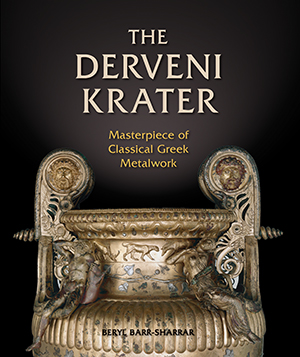The Derveni Krater: Masterpiece of Classical Greek Metalwork

by Beryl Barr-Sharrar
Ancient Art and Architecture in Context 1
255 pp, 168 figs, 1 map, 32 col pls
9.5" x 11.5"
Cloth, ISBN: 978-0-87661-962-9
Publication Date: Nov 2008
Status: Active
Retail Price $75
BUY PRINT
VIEW ONLINE
This beautifully illustrated book represents the first full publication of the most elaborate metal vessel from the ancient world yet discovered. Found in an undisturbed Macedonian tomb of the late 4th century B.C., the volute krater is a tour de force of highly sophisticated methods of bronze working. An unusual program of iconography informs every area of the vessel. Snakes with copper and silver inlaid stripes frame the rising handles, wrapping their bodies around masks of underworld deities. On the shoulder sit four cast bronze figures: on one side a youthful Dionysos with an exhausted maenad, on the other a sleeping Silenos and a maenad handling a snake. In the major repoussé frieze on the body a bearded hunter is associated with Dionysian figures. What was the function of this extraordinary object? And what is the meaning of the intricate iconography? The krater is placed in its Macedonian archaeological context as an heirloom of the descendants of the man named in the Thessalian inscription on its rim, and in its art-historical context as a highly elaborated, early-4th-century version of a metal type known in Athens by about 470 B.C.
About the Author: Beryl Barr-Sharrar is Adjunct Professor of Fine Arts at the Institute of Fine Arts, NYU. She is the author of numerous publications on Classical and Hellenistic art.
Reviews:
"Beryl Barr-Sharrar's new monograph on the Derveni Krater breaks entirely new ground, elevating this masterpiece of later classical Greek art to a status alongside those of the Mausoleum at Halicarnassus and the Alexander Sarcophagus as the most important monuments of Greek art in the fourth century B.C. She shows that bronze vases, which have hitherto been included in the minor arts, now deserve their own place alongside architecture, sculpture and painted vases as high arts. In addition, the sophistication and care of the layout and the book production reaches new heights of what an outstanding publication of a work of Greek art can be." David Mitten, Harvard University
"Spectacular! A book such as this appears on one's desk once in a decade: a definitive publication of a masterpiece of Greek art that is comprehensive, informative, persuasive, and beautifully illustrated." Andrew Stewart, UC Berkeley
"This is a penetrating study of a sumptuous artifact, with superb photographic documentation in color; a very handsome publication." R. R. R. Smith, Oxford University
